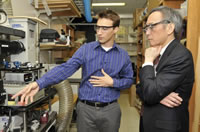Jeremy Munday
 Jeremy Munday went to graduate school at Harvard and now he's doing post doctoral
work at Cal Tech. What got him there?
Jeremy Munday went to graduate school at Harvard and now he's doing post doctoral
work at Cal Tech. What got him there?
A waning interest in the recording industry replaced with support from the MTSU Physics Department
Munday, a resident of Melbourne, Fla., came to MTSU as a recording industry major. While his love for music ran deep, he decided success would be determined more by who he knew than what he knew. So, he took the Physics in Music course and found that he could marry music with a more technical, scientific side that attempted to explain why things worked the way they did.
"That was some of the stuff I was craving from the RIM classes," Munday said. "How sound works, the technical details of acoustics, how electronics plays into that and how musical instruments work. That left me wanting to know a lot more."'
And Munday was able to discover a lot more. Since MTSU has no graduate program, he said, undergraduates have unheard of access to professors, labs and equipment. Munday not only did research on topics related to music like acoustics, he was published four times as an undergraduate with his name appearing right next to his professors. He's convinced that's a major reason why he received consideration from nationally ranked universities. Munday says doing research and conducting experiments gave him confidence that he really understood what he was learning in class.
"We went to the hardware store and bought PVC pipe," Munday remembered. "We joined it together, got a speaker and a microphone, and took measurements. It was great to see you could have an idea and then do an experiment to get results that were comprehendible as an undergraduate."
As you can tell, Munday didn't just study physics at MTSU – he did physics.
If you'd like to know how a physics principle let's you see music as well as hear it, check out http://www.youtube.com/watch?v=HpovwbPGEoo.


